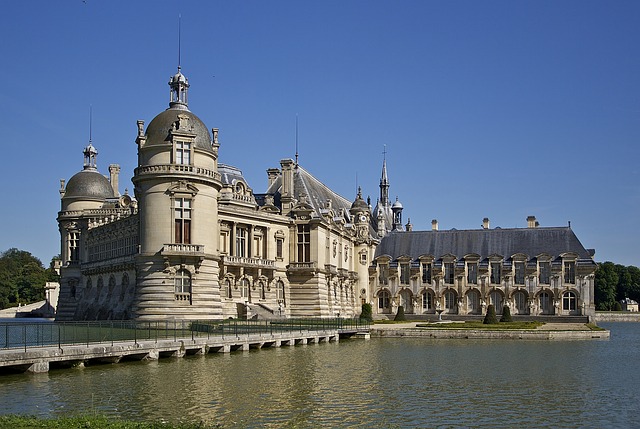
Château de Chantilly, 60500 Chantilly
Built from the XIVth to the XVIIIth century, Chantilly is a perfect example of the Renaissance style. Which means esthetics are going to be present!
As soon as you arrive, you are welcomed by the statue of Anne de Montmorency riding his trusty steed, guarding the majestic entrance of the fortress. All around the castle, a wide moat and an esplanade give the feeling that the residence dominate the area.
A breathtaking view!
One of the strong points of Chantilly: Les Grandes Ecuries. With a 28 meter high dome and the potential to hold 240 horses, they are the biggest stables in all of Europe. Many demonstrations and shows take place there, with the possibility to go behind the scenes and learn about the lifestyle of the horse riders. You will also find the horse museum there; if you are more interested in the history and representation of horses in our civilization, be sure not to miss this unique experience!
Feel like a royal by visiting the Domaine de Chantilly
Undoubtedly Chantilly’s best-known feature is the opulent castle that bears the town’s name. The domain is made up of two attached buildings. The first, known as the Petit Château (small castle), was built in around 1560 for the French noble, Anne, the Duke of Montmorency. The second, the Grand Château (large or grand castle), was largely destroyed during the French Revolution and reconstructed by architect Honoré Daumet for Henri d’Orléans, Duke of Aumale in the 19th century. Nowadays, this opulent estate is home to several museums, a spectacular garden (said to be famous French gardener Le Nôtre’s best work) and the largest horse stables in Europe.
One of the museums inside the Domaine de Chantilly is the Musée Condé, considered to be one of the most prestigious art galleries in the country. Designed in the 19th century by Henri d’Orléans, Duke of Aumale, to display his extensive art collection, the layout of the paintings remains unchanged since. After the Louvre, the Musée Condé houses the second-largest number of antique paintings in the country.
A salon in the Musée Condé © Mel22 / WikiCommonn

Join in on Chantilly’s equestrian frenzy
Upon a visit to Chantilly, you’ll quickly notice its love of horses. Horseracinghas been famous here since 1834 and the town is one of the principal training centres in France. Discover the history and role of this beloved animal at the Musée du Cheval (Museum of the Horse), found in Les Grandes Écuries (The Great Stables) at the Chantilly Castle. Here, visitors will learn about this symbol of prestige and power through a collection of paintings, sculpture and ethnographic objects.
Learn about ancient hydraulic techniques at the Pavillon de Manse
The Pavillion de Manse, also known as the Moulin des Princes (Prince’s Mill), has been using water from a canal off the Nonette river to produce energy since 1678. Another invention of the Duke of Aumale, its inception was initially to provide vast amounts of water to Domaine de Chantilly to use in the fountains and jets in its gardens, as imagined by Le Nôtre. Visitors will get an in-depth look at the evolution of the generator inside this Pavillon, located in a classical French building designed by architect Jules Hardouin-Mansart, the same man behind the Grand Trianon and the Hall of Mirrors at Versailles.
Comments
Post a Comment